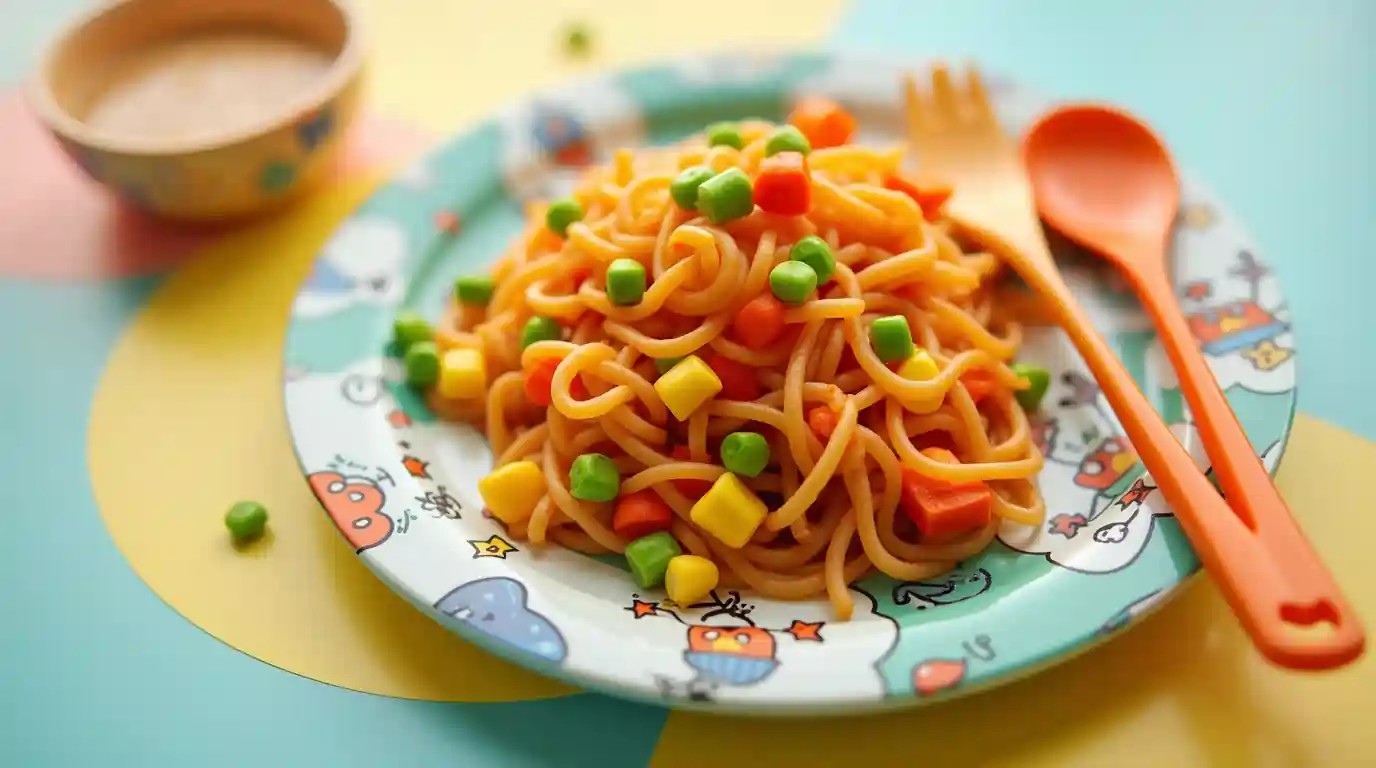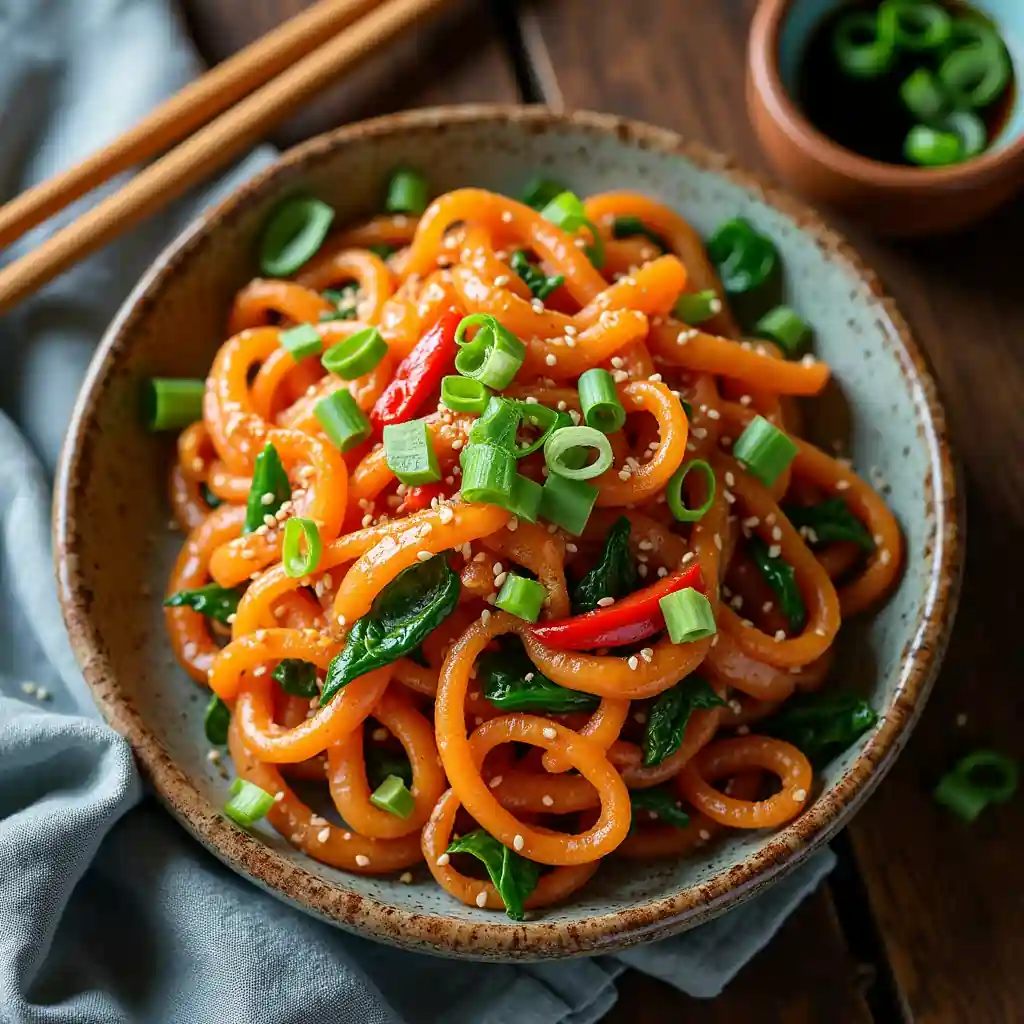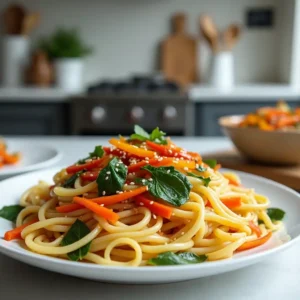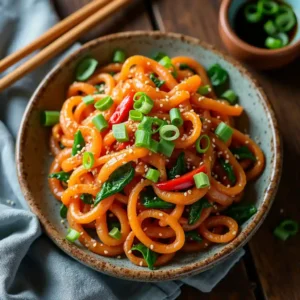What Are Sweet Potato Glass Noodles?
Sweet potato glass noodles are a type of noodle made primarily from sweet potato starch. Known for their glossy, transparent appearance once cooked, they are a staple in Korean, Chinese, and Southeast Asian cuisines. Their chewy texture and neutral flavor make them an excellent base for absorbing sauces, spices, and broths, allowing them to complement a variety of dishes seamlessly.
Compared to traditional wheat noodles, sweet potato glass noodles stand out as a healthier option. Not only are they gluten-free, but they also contain fewer calories, making them ideal for those seeking lighter, more nutritious meals. Whether you’re crafting a hearty stir-fry, a soothing soup, or even a cold salad, these noodles are endlessly versatile.
Nutritional Benefits of Sweet Potato Glass Noodles
Sweet potato noodles are packed with complex carbohydrates, offering slow-releasing energy that helps stabilize blood sugar levels and keeps you feeling full longer. They’re also naturally low in calories, with only about 80 calories per 100 grams, compared to the 138 calories found in wheat noodles. This makes them a smart choice for anyone looking to manage their weight while still enjoying satisfying meals.
Additionally, sweet potato noodles are gluten-free and allergen-friendly, making them a suitable choice for individuals with dietary restrictions. To better understand their nutritional benefits, let’s compare them to traditional wheat noodles:
| Nutrient | Sweet Potato Glass Noodles (100g) | Traditional Wheat Noodles (100g) |
|---|---|---|
| Calories | 80 | 138 |
| Carbohydrates | 20g | 30g |
| Gluten-Free | Yes | No |
How to Cook Sweet Potato Glass Noodles Perfectly
Cooking sweet potato noodles is simple, but a few tips can ensure perfect results every time. Start by boiling a pot of water. Once it’s at a rolling boil, add the noodles and let them cook for about 5–7 minutes. They should soften but still retain their signature chewiness.
Once cooked, strain the noodles and give them a quick rinse under cold running water. This step is crucial to prevent clumping and to maintain their springy texture. If you’re planning to stir-fry or store them for later use, toss them with a bit of sesame oil to keep them from sticking together.
Common mistakes to avoid include overcooking, which can make the noodles mushy, and skipping the rinse step, which may lead to clumping. By following these simple steps, you’ll have perfectly cooked sweet potato noodles every time.

Delicious Recipes Using Sweet Potato Glass Noodles
Classic Korean Japchae (Stir-Fried Sweet Potato Noodles)
Japchae is one of the most popular dishes featuring sweet potato noodles. It’s a flavorful stir-fry combining sweet and savory elements. Here’s what you’ll need:
| Ingredient | Quantity |
|---|---|
| Sweet Potato Noodles | 200g |
| Soy Sauce | 2 tbsp |
| Sesame Oil | 1 tbsp |
| Carrots (julienned) | 1 cup |
| Spinach (blanched) | 1 cup |
| Onion (sliced) | 1 small |
| Protein (beef or tofu) | 100g |
- Cook the noodles as directed and set them aside.
- In a pan, heat sesame oil and sauté onions, carrots, and your chosen protein.
- Add blanched spinach and soy sauce, then toss in the noodles.
- Stir-fry until everything is well mixed, and serve warm.
Sweet Potato Noodle Soup
For a comforting dish, sweet potato noodles shine in a hearty broth. Here’s a simple recipe:
| Ingredient | Quantity |
|---|---|
| Sweet Potato Noodles | 200g |
| Chicken or Vegetable Broth | 4 cups |
| Soy Sauce | 2 tbsp |
| Ginger (minced) | 1 tsp |
| Vegetables (your choice) | 1 cup |
| Protein (optional) | 100g |
- Boil the broth and add minced ginger for flavor.
- Add your vegetables and protein, cooking until tender.
- Drop in the cooked noodles and simmer for a few minutes.
- Serve hot, garnished with green onions or sesame seeds.
Where to Buy Sweet Potato Glass Noodles
Finding quality sweet potato glass noodles is easier than you think. Most Asian grocery stores carry them, especially in the noodle or gluten-free sections. You can also find them online on platforms like Amazon or specialty Asian stores. When purchasing, always check the ingredient list. Opt for noodles made with 100% sweet potato starch and avoid brands with added fillers or preservatives.
Tips and Tricks for Storing Sweet Potato Glass Noodles
Uncooked sweet potato noodles should be stored in a cool, dry place, ideally in an airtight container. Once cooked, they can be refrigerated for up to three days. To prevent clumping, toss the noodles with a small amount of oil before storing them in an airtight container. When reheating, use a stovetop or microwave, adding a splash of water or sauce to restore their original texture.
Creative Ways to Use Sweet Potato Glass Noodles
Sweet potato glass noodles aren’t just for stir-fries and soups; their versatility allows you to create unique and creative dishes. One fun idea is to use them as a filling for wraps or spring rolls. Their chewy texture pairs beautifully with crisp vegetables and a tangy dipping sauce. Another option is to bake them into noodle-stuffed bell peppers for a hearty and colorful meal. You can even use them in casseroles as a gluten-free replacement for lasagna sheets or layer them in baked dishes for added depth.
For a fusion twist, try sweet potato glass noodles in tacos or as a base for a noodle burger. They also work well in salads, providing a satisfying bite when paired with fresh greens, shredded carrots, and a zesty lime vinaigrette. Whether hot or cold, these noodles are a blank canvas for your culinary creativity.
Health Comparisons: Sweet Potato Glass Noodles vs. Other Gluten-Free Alternatives
When it comes to gluten-free options, sweet potato glass noodles hold their own against other alternatives. Compared to rice noodles, sweet potato noodles often have fewer calories and a slightly firmer texture, making them ideal for stir-frying. Unlike zucchini noodles, which are prone to becoming soggy, sweet potato noodles maintain their chewiness, even when reheated.
Chickpea or lentil pasta offers higher protein content, but sweet potato noodles stand out for their low-calorie count and neutral flavor, which makes them a versatile option for a variety of dishes. Quinoa pasta may have a more robust taste, but sweet potato noodles excel when you want a subtler base that absorbs the flavors of your dish. For those on a gluten-free diet seeking a balanced carb source, sweet potato noodles strike the perfect balance between taste and nutrition.
Kid-Friendly Recipes
Kids can be picky eaters, but sweet potato glass noodles are a hit thanks to their fun texture and ability to take on familiar flavors. One easy recipe is to make a sweet and savory stir-fry with a mild soy-honey glaze. Add colorful vegetables like bell peppers and peas for visual appeal and a healthy boost.

For younger children, you can try a cheesy sweet potato noodle bake. Toss the noodles with a creamy cheese sauce and bake until golden and bubbly. Another idea is to create noodle cups using muffin tins—fill each cup with cooked noodles, scrambled eggs, and diced veggies, then bake until set. These bite-sized noodle treats are perfect for lunchboxes or snack time.
Common Mistakes When Cooking Sweet Potato Glass Noodles and How to Avoid Them
Cooking sweet potato glass noodles is simple, but a few common pitfalls can affect the final dish. One mistake is overcooking the noodles, which can turn them mushy. To avoid this, follow the recommended cooking time of 5–7 minutes and taste-test for doneness. Another error is skipping the rinse step after cooking. Rinsing the noodles in cold water not only stops the cooking process but also prevents clumping, ensuring a smooth texture.
Using too little sauce can leave the noodles bland since they rely on absorbing flavors. Be generous with seasonings and sauces to elevate your dish. If your noodles are too sticky, tossing them with a small amount of sesame oil after rinsing can help separate them and enhance their flavor. By paying attention to these details, you’ll achieve perfectly cooked noodles every time.
Sweet Potato Glass Noodles for Meal Prep
Sweet potato glass noodles are a fantastic choice for meal prepping because they maintain their texture and flavor when stored properly. Prepare a batch of noodles and divide them into containers with stir-fried vegetables, tofu, or chicken for a balanced meal. Add different sauces, such as a peanut-based dressing or soy-ginger glaze, to keep your meals interesting throughout the week.
For soups, store the noodles separately from the broth to prevent them from becoming overly soft. When you’re ready to eat, simply combine the two and heat. You can also prepare noodle salads with crisp vegetables and store them in mason jars for a grab-and-go lunch option. With their versatility and ability to stay fresh, sweet potato noodles make weekly meal prep both convenient and exciting.
Versatile Noodles Tailored for Special Diets
Sweet potato glass noodles are an excellent option for those following special diets. For vegans, pair the noodles with plant-based proteins like tofu or tempeh, and enhance the dish with vegetables and a flavorful sesame sauce. If you’re on a keto diet, sweet potato noodles can still fit in as a low-carb treat when balanced with high-fat, low-carb ingredients like avocados or coconut-based sauces.
For paleo enthusiasts, these noodles are a compliant alternative to grains and pair wonderfully with lean proteins and fresh herbs. Low-sodium diets can benefit from sweet potato noodles when cooked with homemade, salt-free sauces and plenty of fresh spices for flavor. No matter your dietary restrictions, sweet potato glass noodles can be easily adapted to suit your nutritional needs and preferences.
FAQs About Sweet Potato Glass Noodles
Are sweet potato glass noodles healthy?
Absolutely. They’re low in calories, gluten-free, and a great alternative for anyone avoiding wheat or looking for a nutritious noodle option.
Can I use sweet potato glass noodles in salads?
Yes! Their chewy texture makes them an excellent addition to cold dishes. Toss them with fresh vegetables, herbs, and a light dressing for a refreshing meal.
How long can I store cooked noodles?
Cooked noodles can be stored in an airtight container in the fridge for up to three days. Just add a little oil to keep them from sticking.
Key Takeaways
Sweet potato glass noodles are a versatile and healthy choice for any kitchen. Their unique texture and ability to absorb flavors make them perfect for a variety of dishes, from stir-fries to soups and salads. Whether you’re gluten-free or simply looking for a lighter alternative to traditional pasta, these noodles are a must-try. Ready to get cooking? Stock your pantry with sweet potato glass noodles today and start exploring their endless culinary possibilities.
Conclusion
Sweet potato glass noodles are more than just an ingredient—they’re a culinary experience. Whether you’re discovering them for the first time or looking for creative ways to enjoy them, they bring something special to every dish. With their nutritional benefits, ease of preparation, and versatility, they’re a pantry staple worth exploring. Why not add them to your next meal and see just how delightful they can be?



